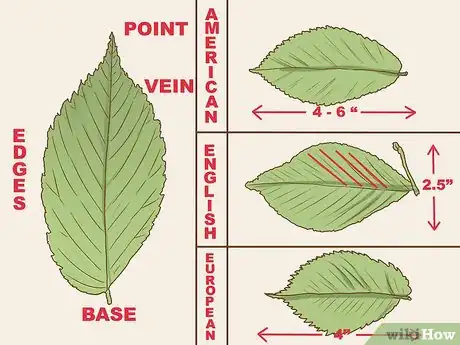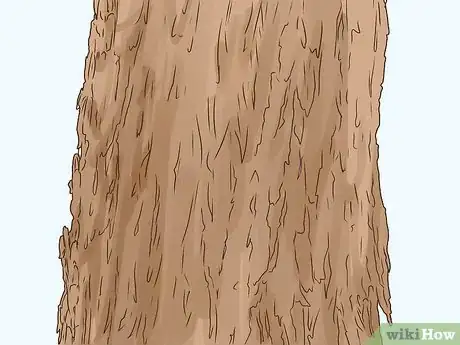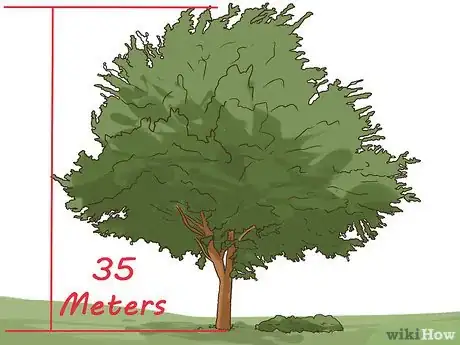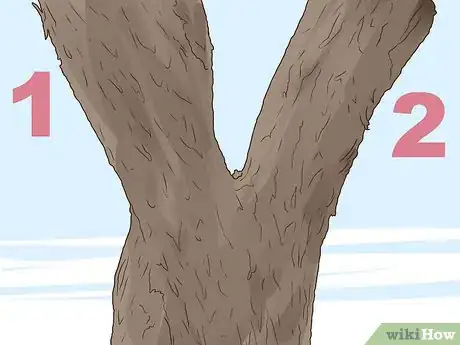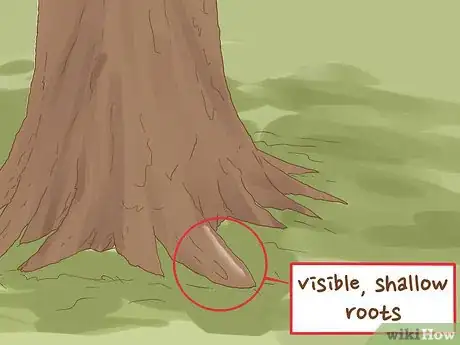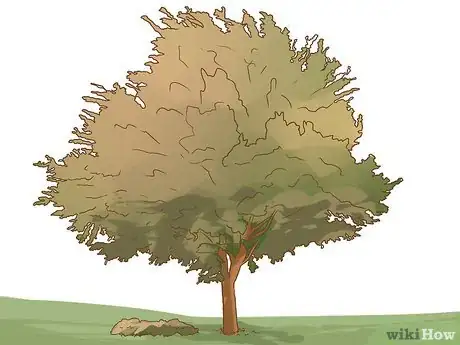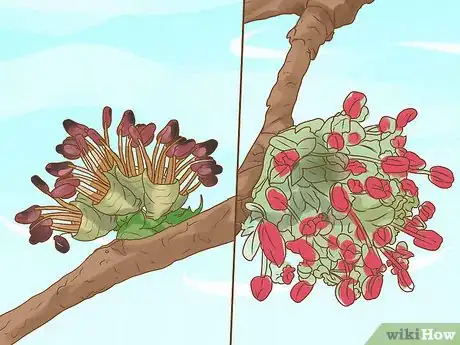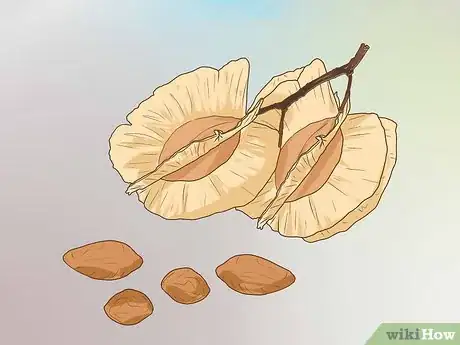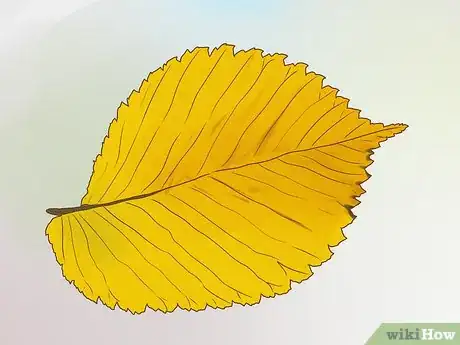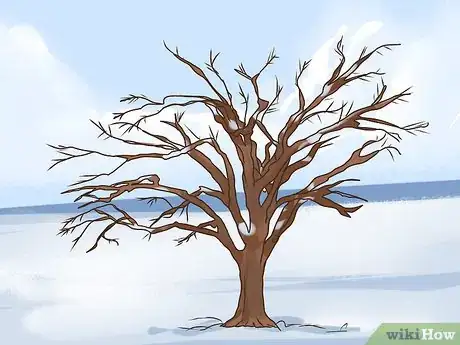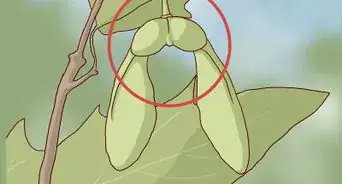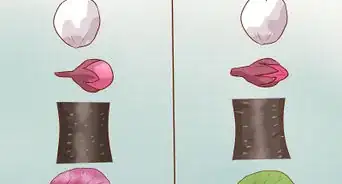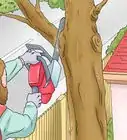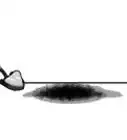This article was co-authored by Matt Bowman. Matt Bowman is a Gardener, Landscaper, the Owner of Georgia Farm to Table, and the Owner of Tradition Property Services in Atlanta, Georgia. With over 20 years experience, he specializes in organic gardening, landscape maintenance, handyman services, homecare services, and supplying Christmas trees. Matt earned a BA in Journalism from the University of Georgia.
There are 17 references cited in this article, which can be found at the bottom of the page.
wikiHow marks an article as reader-approved once it receives enough positive feedback. This article received 22 testimonials and 88% of readers who voted found it helpful, earning it our reader-approved status.
This article has been viewed 840,834 times.
Ideal for providing shade in backyard and along neighborhood streets, the elm tree is one of the most common trees. Its many varieties are present all over the world. There are more than 30 species of elm, but most share several common features: green, toothed leaves that turn yellow in fall, bark that is deeply ridged and grey-brown in color, and a roughly vase-like shape make the tree easily distinguishable from others. Sadly, the presence of Dutch elm disease threatens many old stands of elms, but its presence can also be used to identify elms.
Steps
Identifying Elms With Basic Characteristics
-
1Examine the leaves of the tree. Elm leaves alternate along two sides of the stem. The leaf is oval in shape and comes to a point at the end. The edges of the leaf are jagged and the veins are prominent. The base of the leaf is slightly asymmetrical. Many varieties of elm leaves are smooth on top and fuzzy on the bottom.[1]
- The leaves of an American elm are typically 10-15 centimeters (4-6 inches) long.
- Leaves of the English Elm are usually ten centimeters (four inches) long and seven centimeters (two and a half inches) wide. They sport 10 to 12 veins.[2]
- European White Elms have up to 17 veins on the front of the leaf and 14 on the bottom.[3]
-
2Look at the bark. The bark of an elm is rough and coarse, with intersecting ridges. The color is a light grey to dark greyish-brown. The bark will be deeply furrowed.[4]
- The Siberian elm is an exception, and often has exfoliated bark that is green or orange in color.
- The bark on the European White Elm, unlike most other species, remains smooth even into maturity.[5]
- Cedar elms have lighter purplish-grey bark than most other varieties.
Advertisement -
3Check for overall height and width. Mature elms reach a height of about 35 meters (115 feet) with a trunk diameter of around 175 centimeters (68 inches). Depending on the species or cultivar, they can reach 9 to 18 meters (30-59 feet) in width. Many American species of elm will actually become larger, with some growing to 39 meters (128 feet) in height and 37 meters (121 feet) in width.
- Elms will usually have a vase or fountain shape.[6]
- Elm trees are a deciduous tree, and they grow about 2–3 ft (0.61–0.91 m) a year, depending on their location.[7]
- If you're trying to figure out how old the tree is, use a tape measure to find the diameter of the trunk. For every 1 ft (0.30 m) in diameter, the tree is at least 8 years old.[8]
-
4
-
5Consider the tree’s location. Use the location of the tree to determine if it could be an elm. Different varieties of elms grow in different places. For instance, American elms are common in the eastern half of the United States, from the Rocky Mountains eastward.[11] They are less common west of the Rockies, though the can be found in California.
- Siberian elms (also known as the Asiatic, Lacebark, or Chinese elm) are common in Central Asia, Mongolia China, Siberia, India, and Korea.
- European elms are common across Europe. Before Dutch elm disease arrived, English elms were also common across Europe, but they are now confined primarily to Portugal, France, Spain, and England.
- If you know there are many elm trees in a certain area and the tree matches approximate descriptions of elm trees, you probably have an elm tree. Look for areas likely to contain thriving elm trees.
- Elms adapt to a variety of climates and planting situations, including poor or mildly salty soil, extreme cold, atmospheric pollution, and drought. However, they prefer areas that are in full sun to part shade with well-drained, but moist, soil.
Looking More Closely at the Tree
-
1Identify what creatures the tree attracts. Many animals, bugs, and birds share the ecosystem with elms. For instance, the American elm attracts birds and mammals (mice, squirrels, and opossums) that feed on its buds. Deer and rabbits will chew the bark and small branches of younger trees. If you see a host of animals and bugs hanging around a tree, it could be an elm.
- Caterpillars might be found munching on the leaves.
- Woodpeckers, raccoons, squirrels, and chickadees are commonly found living in elms.
- Slippery elms also attract birds, who like to snack on the tree’s fruit and buds.
-
2Look for visible roots. The base of an elm is reinforced with a visible, shallow root system with a broad reach. The bark of the roots will have the same general texture and color as the bark on the rest of the tree. While it might not be present in young elms, look for roots that are visible along the ground.[12]
-
3Look for sick trees. Elm trees are commonly afflicted with Dutch elm disease. As its name implies, the disease only affects elm trees, so if you see a tree with the symptoms of Dutch elm disease, you can safely conclude it is an elm. Look for:
- Dead leaves that have not fallen off the tree
- Yellowing or other discoloration in fall or spring
- Wilting leaves and young shoots present at the same time
Identifying Seasonal Changes Associated With Elms
-
1Look for flowers. Depending on your species of elm, you may or may not have flowers in the spring. European White Elms, for instance, sprout small purple flowers in early spring.[13] Wych Elms have similar reddish purple flowers that sprout at the same time.[14]
- The Caucasian Elm, by contrast, has small green flowers that also emerge in spring.[15]
- English Elms sprout red flowers in small clusters early in spring.[16]
- Flowers may be hidden behind the leaves of the elm if the tree has already produced leaves, so look closely before deciding whether a tree is an elm or not.
-
2Look at the seeds of the elm. Elm seeds form and fall from the trees in springtime soon after flowering. They are distinctive in appearance. Elm seeds are round, flat and covered by a thin, paper-like casing that hooks at the top.[17]
- Most elms bear single seeds about the size of a pea.
- The seeds are encased in a green, thin, ovular case the resembles an insect wing called a samara.[18]
- When mature, the seeds will change from green to a hay-like yellow-brown tone.
-
3Examine elms in the fall. Check trees in autumn when the leaves are changing colours. Many species of elm trees have leaves that will turn a bright yellow in fall, and sometimes a yellowish-purple colour. For instance, leaves on the Wych Elm and English Elm are renowned for turning bright yellow in autumn.[19] The leaves often may be hiding blooms that are still present from late summer, so look carefully before judging whether a tree is an elm or not.
-
4Examine the tree in the winter. Elms are deciduous, meaning they shed their leaves once each year, starting in the fall.[20] By the winter, they will be bare of leaves, and then in the spring they will start to re-grow their leaves. If you notice this foliage pattern, you might have an elm.
Expert Q&A
-
QuestionHow long does it take an elm tree to grow to full height?
 Matt BowmanMatt Bowman is a Gardener, Landscaper, the Owner of Georgia Farm to Table, and the Owner of Tradition Property Services in Atlanta, Georgia. With over 20 years experience, he specializes in organic gardening, landscape maintenance, handyman services, homecare services, and supplying Christmas trees. Matt earned a BA in Journalism from the University of Georgia.
Matt BowmanMatt Bowman is a Gardener, Landscaper, the Owner of Georgia Farm to Table, and the Owner of Tradition Property Services in Atlanta, Georgia. With over 20 years experience, he specializes in organic gardening, landscape maintenance, handyman services, homecare services, and supplying Christmas trees. Matt earned a BA in Journalism from the University of Georgia.
Gardener & Owner, Tradition Market & Garden
-
QuestionHow long does it take an elm tree to grow to its full mature height?
 Matt BowmanMatt Bowman is a Gardener, Landscaper, the Owner of Georgia Farm to Table, and the Owner of Tradition Property Services in Atlanta, Georgia. With over 20 years experience, he specializes in organic gardening, landscape maintenance, handyman services, homecare services, and supplying Christmas trees. Matt earned a BA in Journalism from the University of Georgia.
Matt BowmanMatt Bowman is a Gardener, Landscaper, the Owner of Georgia Farm to Table, and the Owner of Tradition Property Services in Atlanta, Georgia. With over 20 years experience, he specializes in organic gardening, landscape maintenance, handyman services, homecare services, and supplying Christmas trees. Matt earned a BA in Journalism from the University of Georgia.
Gardener & Owner, Tradition Market & Garden Elm trees are a slow-growing deciduous tree, so they take a long time to reach their full height. They grow around 2-3 ft a year, depending on their location and exact microclimate.
Elm trees are a slow-growing deciduous tree, so they take a long time to reach their full height. They grow around 2-3 ft a year, depending on their location and exact microclimate. -
QuestionDo morel mushrooms grow around elm trees?
 Community AnswerYes, morels are often found beneath the shade of elm trees. Dead elms, especially, are often a popular place for morel mushrooms.
Community AnswerYes, morels are often found beneath the shade of elm trees. Dead elms, especially, are often a popular place for morel mushrooms.
References
- ↑ https://www.woodlandtrust.org.uk/trees-woods-and-wildlife/british-trees/a-z-of-british-trees/wych-elm/
- ↑ https://books.google.com/books?id=tYV91AIRPmQC&lpg=PA344&pg=PA135#v=onepage&q&f=false
- ↑ https://books.google.com/books?id=tYV91AIRPmQC&lpg=PA344&pg=PA134#v=onepage&q&f=false
- ↑ https://www.edmonton.ca/programs_services/pests/elm-tree-identification
- ↑ https://books.google.com/books?id=tYV91AIRPmQC&lpg=PA344&pg=PA134#v=onepage&q&f=false
- ↑ http://www.mortonarb.org/trees-plants/tree-plant-descriptions/elm-cultivars
- ↑ Matt Bowman. Gardener & Owner, Tradition Market & Garden. Expert Interview. 21 April 2020.
- ↑ Matt Bowman. Gardener & Owner, Tradition Market & Garden. Expert Interview. 21 April 2020.
- ↑ https://books.google.com/books?id=5b68DsGlvVIC&lpg=PA188&pg=PA188#v=onepage&q&f=false
- ↑ http://natureinstitute.org/pub/ic/ic14/trees.htm
- ↑ https://www.arborday.org/programs/nationaltree/elm.cfm
- ↑ https://extension.umn.edu/identify-invasive-species/siberian-elm
- ↑ https://books.google.com/books?id=tYV91AIRPmQC&lpg=PA344&pg=PA134#v=onepage&q&f=false
- ↑ https://books.google.com/books?id=tYV91AIRPmQC&lpg=PA344&pg=PA136#v=onepage&q&f=false
- ↑ https://books.google.com/books?id=tYV91AIRPmQC&lpg=PA344&pg=PA139#v=onepage&q&f=false
- ↑ https://books.google.com/books?id=tYV91AIRPmQC&lpg=PA344&pg=PA135#v=onepage&q&f=false
- ↑ https://www.woodlandtrust.org.uk/trees-woods-and-wildlife/british-trees/a-z-of-british-trees/wych-elm/
- ↑ https://books.google.com/books?id=tYV91AIRPmQC&lpg=PA344&pg=PA134#v=onepage&q&f=false
- ↑ https://books.google.com/books?id=tYV91AIRPmQC&lpg=PA344&pg=PA139#v=onepage&q&f=false
- ↑ http://www.mortonarb.org/trees-plants/tree-plant-descriptions/elm-cultivars
About This Article
If you’re not sure how to identify an elm tree, start by examining the leaves. Elm leaves are oval-shaped and come to a point at the end, with jagged edges and prominent veins. The base of the leaf is slightly asymmetrical, and the leaves may be smooth on top and fuzzy on the bottom. Next, check the bark of the tree. An elm tree’s bark is rough, deeply furrowed, and can range in color from light grey to dark greyish brown. To learn how to identify the seeds of an elm tree, read on!
